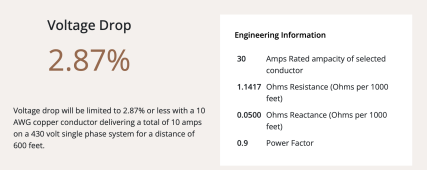Looking for feedback on a solar install where the place we need the power is 600ft from an open field in the woods surrounded by tall trees.
Have a remote property that we purchased, and the bunkhouse is in the woods and to get to the open field is a 600ft run. The utility ran underground power 400+ ft from the transformer to the meter with a 200 amp panel breaker/service(20+ years ago). In July(Florida location) the peak hour was 13KWh, so assume a 50 amp average indicating AC on in the house and the workshop.
Planning an expansion of larger building out to the "open field area", so long term that will become the primary driver of power. Would like to centralize solar and SOL-ARK 15K, batteries, generators out in the field given that SOL-ARK can expand capacity by adding additional units.
When I did the voltage drop calculator from Southwire can't do a wire big enough for a 600ft run at 240V and 200 amps. Even at 240V and 100 amps would require a 600KCMIL cable which is direct burial and very expensive at $18 a foot for 750-750-500. Going with a 240-480 to 480-240 voltage 50KVA transformer from Maddox is $2200 each for $4400 then allows for 4/0 cable($6 a foot). This solves the getting power to the existing panel at a cost of $8000. To add in the ability to net meter and run off the grid would need to add an additional appropriately rated cable to bring power from the meter 600ft to the SOL-ARK unit trying to centralize in the field. Assuming SOL-ARK 15K, when running off of the grid doesn't do a AC-DC transform and then back to AC for the load, so if the meter is the primary source of voltage, it is already 400ft to the meter from the utility company transformer plus 600ft to the solar hut and then 600ft back to the main panel. Not good.
Option B is to put SOL-ARK and batteries at the existing panel/meter location and run high voltage DC from 10KW of panels over three strings to the SOL-ARK DC input. for 10 panels per string 43V per panel at 10 amps = 430V. Running three strings 600 ft of 4-4-4 wire is $2000 in wire costs. Saving $6000 and in theory, a more optimal interface to the grid.
As we add buildings out in the field(farming related) would not be able to leverage existing solar/AC/grid infrastructure. With net metering, any excess solar beyond topping off the batteries can go back as a credit and in theory could use that as a virtual meter credit if we end up adding another meter out in the field. Not really worried about net metering, but don't want to do anything that prevents it if the future is going to bring KWh rates 2X and 3X what we have today.
Has anyone found a reasonable price 50KVA 240-480V transformer for less than $2000? Ideally would like to do 240-600 if the wire for direct burial is rated for 600V but haven't found that option. The best options I could find was at maddoxtransformer.com
Any good options for wire? The prices are coming down but still a major cost. The best price bulk cable I can find and includes free delivery is at
https://nassaunationalcable.com/collections/clearance-sale
Has anyone gone the high voltage DC route for 10KW of solar over 500+ ft and had issues/problems?



